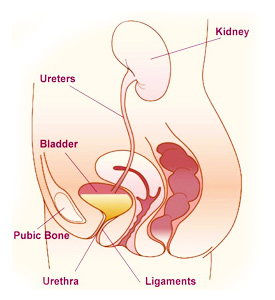URINARY INCONTINENCE
Bladder symptoms affect women of all ages. However, bladder problems are most prevalent among older women. Up to 35% of the total population over the age of 60 years is estimated to be incontinent, with women twice as likely as men to experience incontinence. One in three women over the age of 60 years are estimated to have bladder control problems.
Bladder control problems have been found to be associated with higher incidence of many other health problems such as obesity and diabetes. Difficulty with bladder control results in higher rates of depression and limited activity levels.
Coital incontinence (CI) is urinary leakage that occurs during either penetration or orgasm and can occur with a sexual partner or with masturbation. It has been reported to occur in 10% to 24% of sexually active women with pelvic floor disorders.

What is urinary incontinence (UI)?
UI is also known as 'loss of bladder control' or 'urinary leakage.' UI is when urine leaks out before you can get to a bathroom. If you have UI, you are not alone. Millions of women have this problem, especially as they get older.
Some women may lose a few drops of urine when they cough or laugh. Others may feel a sudden urge to urinate and cannot control it. Urine loss can also occur during sexual activity and can cause great emotional distress.
What causes UI?
UI is usually caused by problems with muscles and nerves that help to hold or pass urine. Urine is stored in the bladder. It leaves the body through a tube that is connected to the bladder called the urethra. Look at the images below to see how this process works.
Muscles in the wall of the bladder contract to force urine out through the urethra. At the same time, sphincter (ss-FINK-ter) muscles around the urethra relax to let the urine pass out of the body.
Incontinence happens if the bladder muscles suddenly contract or the sphincter muscles are not strong enough to hold back urine.
UI is twice as common in women as in men. Pregnancy, childbirth, and menopause are major reasons why. But both women and men can become incontinent from brain injury, birth defects, stroke, diabetes, multiple sclerosis, and physical changes associated with aging.
Pregnancy Unborn babies push down on the bladder, urethra (tube that you urinate from), and pelvic floor muscles. This pressure may weaken the pelvic floor support and lead to leaks or problems passing urine.
Childbirth Many women leak urine after giving birth. Labor and vaginal birth can weaken pelvic floor support and damage nerves that control the bladder. Most problems with bladder control during pregnancy and childbirth go away after the muscles have time to heal. Talk to your doctor if you still have bladder problems 6 weeks after childbirth.
Menopause Some women have bladder control problems after they stop having periods. After menopause, the body stops making the female hormone estrogen. Some experts think this loss of estrogen weakens the urethral tissue.
Other causes of UI that can affect women and men are:
Constipation Problems with bladder control can happen to people with long-term (chronic) constipation.
Medicines UI may be a side effect of medicines such as diuretics ( water pills used to treat heart failure, liver cirrhosis, hypertension, and certain kidney diseases). Hormone replacement has been shown to cause worsening UI.
Caffeine and alcohol Drinks with caffeine, such as coffee or soda, cause the bladder to fill quickly and sometimes leak.
Infection Infections of the urinary tract and bladder may cause incontinence for a short time. Bladder control returns when the illness goes away.
Nerve damage Damaged nerves may send signals to the bladder at the wrong time, or not at all. Trauma or diseases such as diabetes and multiple sclerosis can cause nerve damage. Nerves may also become damaged during childbirth.
Excess weight Being overweight is also known to put pressure on the bladder and make incontinence worse.

What are the types of UI?
Stress incontinence Leakage happens with coughing, sneezing, exercising, laughing, lifting heavy things, and other movements that put pressure on the bladder. This is the most common type of incontinence in women. It is often caused by physical changes from pregnancy, childbirth, and menopause. It can be treated and sometimes cured.
Urge incontinence This is sometimes called "overactive bladder." Leakage usually happens after a strong, sudden urge to urinate. This may occur when you don't expect it, such as during sleep, after drinking water, or when you hear or touch running water.
Functional incontinence People with this type of incontinence may have problems thinking, moving, or speaking that keep them from reaching a toilet. For example, a person with Alzheimer's disease may not plan a trip to the bathroom in time to urinate. A person in a wheelchair may be unable to get to a toilet in time.
Overflow incontinence Urine leakage happens because the bladder doesn't empty completely. Overflow incontinence is less common in women.
Mixed incontinence This is 2 or more types of incontinence together (usually stress and urge incontinence).
Transient incontinence Urine leakage happens for a short time due to an illness (such as a bladder infection or pregnancy). The leaking stops when the illness is treated.
How do I talk to my doctor about UI?
Many women do not want to talk to their doctor about such a personal topic. But UI is a common medical problem. Millions of women have the same problem. Many have been treated successfully. Your doctor has probably heard many stories like yours.
Even if you feel shy, it is up to you to take the first step. Some doctors don't treat bladder control problems, so they may not think to ask about it. They might expect you to bring up the subject.
Family practitioners and internists can treat bladder problems. If your doctor does not treat such problems, ask for help finding a doctor who does, such as a urologist, OB/GYN, or urogynecologist.
Here are some questions to ask your doctor:
Could what I eat or drink cause bladder problems?
Could my medicines (prescription and over-the-counter) cause bladder problems?
Could other medical conditions cause loss of bladder control?
What are the treatments to regain bladder control? Which one is best for me?
What can I do about the odor and rash caused by urine?
It also helps to keep a bladder diary. This means you write down when you leak urine. Be sure to note what you were doing at the time, such as sneezing, coughing, laughing, stepping off a curb, or sleeping. Take this log with you when you visit your doctor.
How do I find out if I have UI?
Schedule a visit with your doctor. Your doctor will ask you about your symptoms and take a medical history, including:
How often you empty your bladder
How and when you leak urine
How much urine you leak
Your doctor will do a physical exam to look for signs of health problems that can cause incontinence. Your doctor also will do a test to figure out how well your bladder works and how much it can hold. For this test, you will drink water and urinate into a measuring pan. The doctor will then measure any urine still in the bladder. Your doctor also may order other tests such as:
Bladder stress test During this test, you will cough or bear down as the doctor watches for loss of urine.
Urinalysis A urinalysis tests your urine for signs of infection or other causes of incontinence.
Ultrasound Sound waves are used to take a picture of the kidneys, bladder, and urethra.
Cystoscopy A doctor places a thin tube connected to a tiny camera in the urethra to look at the inside of the urethra and bladder.
Urodynamics A doctor places a thin tube into your bladder and your bladder is filled with water. The doctor then measures the pressure in the bladder.
Your doctor may ask you to write down when you empty your bladder and how much urine you produce for a day or a week.

How is UI treated?
There are many ways to treat UI. Your doctor will work with you to find the best treatment for you.
Types of treatments include:
1) BEHAVIOURAL TREATMENTS
By changing some basic behaviors, you may be able to improve your UI. Behavioral treatments include:
a) Pelvic muscle exercises (Kegel exercises)
Exercising your pelvic floor muscles regularly can help reduce or cure stress leakage. A doctor or nurse can teach you the right way to do the exercises if needed. A pelvic floor physical therapist may be available in your area to help teach you how to strengthen these muscles or help you with other treatments. To do Kegel exercises:
First, try practicing these exercises while lying down.
Squeeze the muscles in your genital area as if you were trying to stop the flow of urine or trying to stop from passing gas. Try not to squeeze the muscles in your belly or legs at the same time. Try to squeeze only the pelvic muscles. Be extra careful not to tighten your stomach, legs, or buttocks.
Relax. Squeeze the muscles again and hold for 3 seconds. Then relax for 3 seconds. Work up to 3 sets of 10 repeats.
When your muscles get stronger, try doing your exercises while sitting or standing. You can do these exercises any time, while sitting at your desk, in the car, waiting in line, doing the dishes, etc.
See your doctor, nurse, or physical therapist to learn how to do these exercises correctly. Kegel exercises are most effective when the patient has received proper instruction from a health care professional. Simply trying to stop your urine flow or trying to do the exercises hundreds of times a day without instruction from a health professional will not help.
b) Bladder Retraining
You may regain bladder control by going to the bathroom at set times, before you get the urge to urinate. You can slowly increase the time between set bathroom trips as you gain control.
c) Weight Loss
Extra weight puts more pressure on your bladder and nearby muscles. This can cause bladder control problems. Work with your doctor to plan a diet and exercise program if you are overweight.
d) Dietary Changes
Some foods and beverages are thought to contribute to bladder leakage. While doctors do not know if these foods really do cause UI, it is reasonable to see if stopping one or all of these items is helpful:
Alcoholic beverages
Carbonated beverages (with or without caffeine)
Coffee or tea (with or without caffeine)
Other changes include drinking fewer fluids after dinner and eating enough fiber to avoid constipation. Also, avoid drinking too much. Six 8-ounce glasses of fluid a day is enough for most people.
e) Quitting Smoking
Researchers are still looking at the link between incontinence and cigarette smoking. Studies show that smokers have more frequent and severe urine leaks.
2) MEDICINES FOR BLADDER CONTROL
Medications can reduce some types of leakage. Some medicines, for example, help relax the bladder muscles and prevent bladder spasms. Talk to your doctor to see if medication is right for you.
It is always important to take your medicine exactly as your doctor tells you to. Also, all drugs have side effects and may affect people differently. Always tell your doctor about any over-the-counter medicines you are taking.
3) DEVICES
A pessary (PESS-uh-ree) is the most common device used to treat stress incontinence. It is a stiff ring that a doctor or nurse inserts into the vagina. The device pushes up against the wall of the vagina and the urethra. This helps reposition the urethra to reduce stress leakage. See your doctor regularly if you use a pessary.
4) NERVE STIMULATION
Some people with urge incontinence may not respond to behavioral treatments or medicine. In this case, electrical stimulation of the nerves that control the bladder may help.
You will be tested to see if this treatment, called neuromodulation (ner-roh-mod-yoo-LAY-shun), can work for you. The doctor will first place a device outside your body to deliver a pulse. If it works well, a surgeon will implant the device.
6) BIOFEEDBACK
Biofeedback helps you learn how your body works. A therapist puts an electrical patch over your bladder and urethral muscles. A wire connected to the patch is linked to a TV screen. You and your therapist watch the screen to see when these muscles contract, so you can learn to control these muscles.
Biofeedback can be used with pelvic muscle exercises and electrical stimulation to help control stress incontinence and urge incontinence.
7) SURGERY
Surgery is most effective for people with stress UI who have not been helped by other treatments. Talk to your doctor about whether surgery would help you, and what type of surgery is best for you.
8) CATHETERIZATION
Surgery is most effective for people with stress UI who have not been helped by other treatments. Talk to your doctor about whether surgery would help you, and what type of surgery is best for you.




